What is Strategic Management?
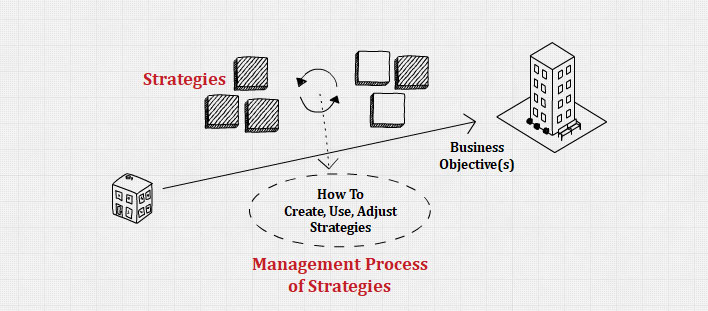
Strategic management is defined as the art and science of formulating, implementing, and evaluating decisions that enable an organization to achieve its objectives and determine its long-term performance.
It includes external environment scanning, internal organization assessment, strategy formulation, strategy implementation, and strategy evaluation and control.
The study of strategic management, therefore, emphasizes the monitoring and evaluating of opportunities and threats in the external environment in alignment with strengths and weaknesses of an organization.
The term strategic management is used synonymously with strategic planning.
Strategic planning is often used in the business world, while strategic management is often used in academia. Sometimes the term strategic management is used to refer to strategy formulation, implementation, and evaluation, with strategic planning referring only to strategy formulation.
A strategic plan is, in essence, a company’s game plan. A company must have a good strategic plan to compete successfully. A strategic plan results from tough managerial choices among numerous good alternatives, and it signals a commitment to specific markets, policies, procedures, and operations.
Strategic Management Benefits
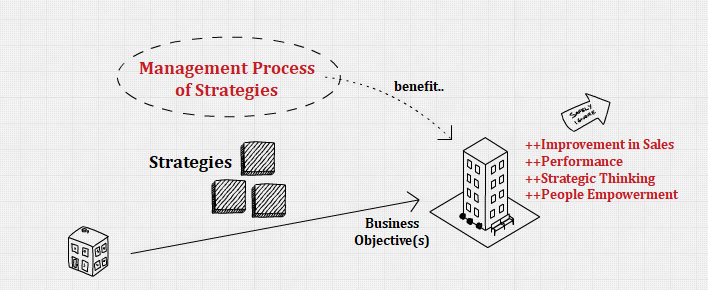
Benefit 1: Improvement in Sales and Profitability
In general, organizations using strategic management concepts are more profitable and successful than those that do not.
Businesses using strategic-management concepts show significant improvement in sales, profitability, and productivity compared to firms without systematic planning activities.
High-performing firms tend to do systematic planning to prepare for future fluctuations in their external and internal environments. Firms with planning systems more closely resembling strategic-management theory generally exhibit superior long-term financial performance relative to their industry.
High-performing firms also seem to make more informed decisions with good anticipation of both short- and long-term consequences. In contrast, firms that perform poorly often engage in activities that are shortsighted and do not reflect good forecasting of future conditions.
Small-sized and medium-sized businesses may plan informally and irregularly. Still, the greater the level of planning, the greater the level of financial performance, especially when measured in terms of sales increases.
Large or divisional corporations may have strategic planning that is complex and time-consuming. It often takes a year for a large company to move from situation assessment to a final decision agreement. Because of the relatively large number of people affected by a strategic decision in a large firm, a formalized and more sophisticated system is needed to ensure that strategic planning leads to successful performance. Otherwise, management becomes isolated and loses sight of the corporate mission and objectives.
Benefit 2: Better Long-Term Performance
The principal benefit of strategic management has always been to help organizations formulate better performance, especially long-term performance, using a more systematic, logical, and rational approach to strategic choice.
Many organizations across the globe can manage short-term high performance, but only a few can actually sustain it over a long period of time. To be successful in the long run, companies must not only be able to execute current activities to satisfy existing markets, but they must also understand and adapt those activities to satisfy new and changing markets.
Strategic management is to emphasize this need for sustainable long-term performance.
In general, organizations that engage in strategic management outperform those that do not. An alignment between the organizational environment, its strategy, structure, and processes have a positive correlation on the long-term performance of the company.
Benefit 3: Facilitate Strategic Thinking, Understanding and Commitment
Formal strategic planning processes improve overall satisfaction with strategic development.
To be effective, however, strategic management needs not always be a formal process. The actual process, rather than the decision or document, is the more important contribution of strategic management.
Communication is a key to successful strategic management.
Understanding is arguably the most important benefit of strategic management. When managers and employees understand what the organization is doing and why, they often feel they are a part of the firm and become committed to assisting it. Managers and employees become surprisingly creative and innovative when they understand and support the firm’s mission, objectives, and strategies.
Thus, the way strategic management is carried out is thus exceptionally important. A major aim of the process is to achieve the understanding of and commitment from all managers and employees. Through involvement in the process as in dialogue and participation, managers and employees become committed to supporting the organization.
The real value of modern strategic management and planning is more in the development of strategic thinking and organizational learning, understanding, and commitment, which arguably provides more long-term results than any written strategic plan.
Benefit 4: People Empowerment
Another benefit of strategic management is the opportunity that the process provides to empower individuals.
Empowerment is the act of strengthening employees’ sense of effectiveness by encouraging them to participate in decision making and to exercise initiative and imagination and rewarding them for doing so.
Firms that have nurtured their managers and employees, shared organizational objectives with them, empowered them to help improve the product or service, and recognized their contributions can turn to them for help in a pinch because of this interaction.
More and more organizations are decentralizing the strategic management process, recognizing that planning must involve lower-level managers and employees. The notion of centralized staff planning is being replaced in organizations by decentralized line-manager planning. The process is learning, helping, educating, and supporting activity, not merely a paper-shuffling activity among top executives.
Strategic management dialogue is more important than a nicely bound strategic management document. Through involvement in the process, line managers become owners of the strategy. Ownership of strategies by the people who have to execute them is a key to success.
Maturity Phase in Strategic Management
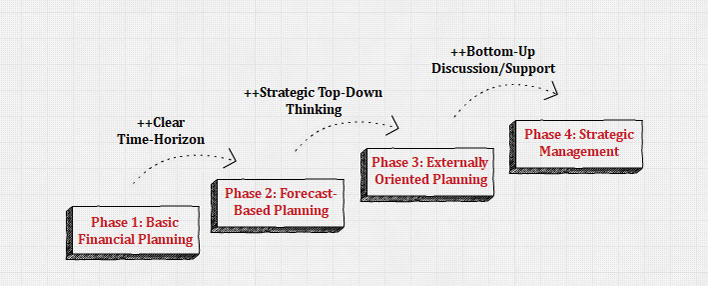
Initially, strategic management is used by large corporations only. Nowadays, however, facing increasing risks of error, costly mistakes, and economic ruin are causing professionals in all organizations to take strategic management much more seriously in order to maintain their competitive advantages in today’s increasingly volatile environment.
An organization generally matures through several phases of strategic management:
Phase 1: Basic Financial Planning
Managers try to collect as many ideas as possible for the proposed budget. Projects are proposed on the basis of very little analysis, with most information coming from within the organization. Salesforce may provide some additional information about the external environment, but in most cases is insufficient. The process of basic financial planning is time-consuming and usually held once a year.
Phase 2: Forecast-Based Planning
Managers attempt to propose five-year plans. Usually, at this point, the proposal consists of projects that span more than one year. Environmental data is collected on an ad-hoc basis and extrapolated five years into the future. The process is usually involved office politics as managers try to compete for larger shares of funds. The time horizon is usually three to five years.
Phase 3: Externally Oriented Planning
Top management takes control of the planning process by initiating strategic planning. Lower-level managers no longer participate in such initiatives, instead, planning activities are now proceeded by planning staff. These people are in charge of specific tasks of developing strategic plans for the organization. Consultants often provide sophisticated techniques and tools that planning staff can use to gather information and forecast future trends. Upper-level managers meet once a year to evaluate and update this current strategic plan.
This top-down approach emphasizes formal strategy formulation and leaves implementation issues to lower management levels. The company is seeking to increase its responsiveness to changing markets and competition by thinking strategically.
Phase 4: Strategic Management
Top management realizes that the best strategic plans are still worthless without the inputs and commitment of lower-level managers. They form planning groups of managers and key employees at many levels, from various departments and workgroups. These people will collectively develop and integrate a series of strategic plans aimed at achieving the objectives of the organization as a whole.
These strategic plans detail implementation, evaluation, and control issues. The sophisticated five-year strategic plan is now replaced with strategic thinking and commitment at all levels of the organization throughout the year. Consultants are available to guide group strategy discussions. Even though top management may still initiate the strategic planning process, the resulted strategies may be delivered from anywhere within the organization. Planning is interactive and people at all levels are now involved.
Challenges in Strategic Management
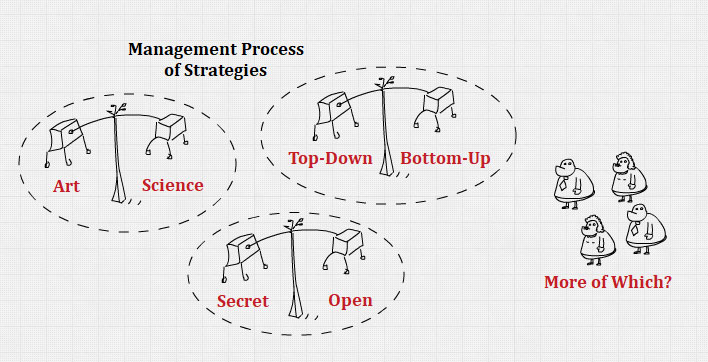
There are 3 challenging decisions that face all management today, regarding strategic management.
They are: (1) deciding whether the process should be more an art or a science, (2) deciding whether strategies should be visible or hidden from stakeholders, and (3) deciding whether the process should be more top-down or bottom-up in their firm.
Challenge 1: Strategic Management as an Art or a Science
The answer to the art versus science question is one that management must decide for themselves. However, strategic management can be viewed more as a science than an art.
This perspective contends that firms need to systematically assess their external and internal environments, conduct research, carefully evaluate the pros and cons of various alternatives, perform analyses, and then decide upon a particular course of action.
There is less room for error in strategic planning. The idea of deciding on strategies for any firm without thorough research and analysis is unwise. Certainly, in smaller firms, there can be more informality in the process compared to larger firms, but even for smaller firms, a wealth of competitive information is available on the Internet and elsewhere and should be collected, assimilated, and evaluated before deciding on a course of action upon which survival of the firm may hinge.
The livelihood of countless employees and shareholders may hinge on the effectiveness of strategies selected. Too much is at stake to be less than thorough in formulating strategies. It is not wise for a firm to rely too heavily on gut feeling and opinion instead of research data, competitive intelligence, and analysis in formulating strategies.
Challenge 2: Exposure of Strategic Management to Stakeholders
An interesting aspect of any competitive analysis discussion is whether strategies themselves should be secret or open within firms.
For a business organization, secrecy may not be best. Keeping strategies secret from employees and stakeholders at large could severely inhibit employee and stakeholder communication, understanding, and commitment and also forgo valuable input that these persons could have regarding the formulation and/or implementation of that strategy.
Thus management in a particular firm must decide for themselves whether the risk of rival firms easily knowing and exploiting a firm’s strategies is worth the benefit of improved employee and stakeholder motivation and input.
There are certainly good reasons to keep the strategy process and strategies themselves visible and open rather than hidden and secret. There are also good reasons to keep strategies hidden from all but top-level executives. Management must decide for themselves what is best for their firms.
Most executives agree that some strategic information should remain confidential to top managers and that steps should be taken to ensure that such information is not disseminated beyond the inner circle.
There are several reasons to be completely open with the strategy process and resultant decisions.
They are: (1) Managers, employees, and other stakeholders can readily contribute to the process. They often have excellent ideas. Secrecy would forgo many excellent ideas; (2) Investors, creditors, and other stakeholders have a greater basis for supporting a firm when they know what the firm is doing and where the firm is going; (3) Visibility promotes democracy, whereas secrecy promotes autocracy. Domestic firms and most foreign firms prefer democracy over autocracy as a management style; and (4) Participation and openness enhance understanding, commitment, and communication within the firm.
There are several reasons why some firms prefer to conduct strategic planning in secret and keep strategies hidden from all but the highest-level executives.
They are: (1) Free dissemination of a firm’s strategies may easily translate into competitive intelligence for rival firms who could exploit the firm given that information; (2) Secrecy limits criticism, second-guessing, and hindsight; (3) Participants in a visible strategy process become more attractive to rival firms who may lure them away; and (4) Secrecy limits rival firms from imitating or duplicating the firm’s strategies and undermining the firm.
The obvious benefits of the visible versus hidden extremes suggest that a working balance must be sought between the apparent contradictions. This balancing act is difficult but essential for the survival of the firm.
Challenge 3: Top-Down or Bottom-Up Strategic Management
Proponents of the top-down approach contend that top executives are the only persons in the firm with the collective experience, acumen, and fiduciary responsibility to make key strategic decisions.
Bottom-up advocates argue that lower and middle-level managers and employees who will be implementing the strategies need to be actively involved in the process of formulating the strategies to ensure their support and commitment.
Management must reach a working balance of the two approaches in a manner deemed best for their firms at a particular time, while cognizant of the fact that current research supports the bottom-up approach.
Increased education and diversity of the workforce at all levels are reasons why middle and lower-level managers, and even non-managers, should be invited to participate in the firm’s strategic planning process, at least to the extent that they are willing and able to contribute.
Guideline to Effective Strategic Management
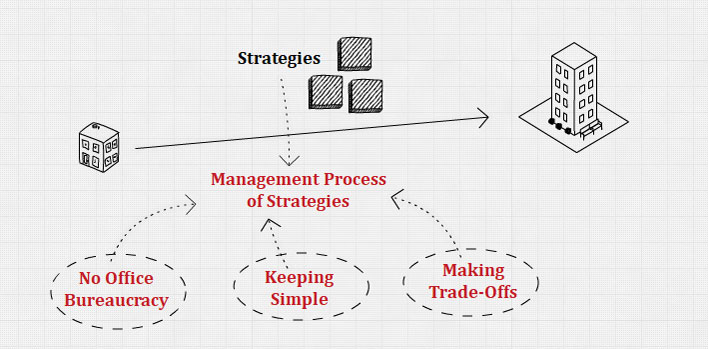
Strategic management must not become a self-perpetuating bureaucratic mechanism.
Rather, it must be a self-reflective learning process that familiarizes managers and employees in the organization with key strategic issues and feasible alternatives for resolving those issues. If the strategy is not working, managers desperately need to know it.
Strategic management must not become ritualistic, orchestrated, or too formal and rigid.
Keep the strategic management process as simple and non-routine as possible. Words supported by numbers, rather than numbers supported by words, should represent the medium for explaining strategic issues and organizational responses.
Strategic management always must eliminate some courses of action in favor of others.
No organization has unlimited resources. No firm can take on an unlimited amount of debt or issue an unlimited amount of stock to raise capital. Therefore, no organization can pursue all the strategies that potentially could benefit the firm. Most organizations can afford to pursue only a few corporate-level strategies at any given time.
Strategic management requires making trade-offs.
Decisions such as long-range versus short-range considerations or maximizing profits versus increasing shareholders’ wealth. Strategy trade-offs require subjective judgments and preferences. In many cases, a lack of objectivity in formulating strategy results in a loss of competitive posture and profitability. Subjective factors such as attitudes toward risk, concern for social responsibility, and organizational culture will always affect strategy-formulation decisions, but organizations need to be as objective as possible in considering qualitative factors.
Strategic planning involves choices that risk resources and trade-offs that sacrifice opportunity. Firms spend resources and focus on a finite number of opportunities in pursuing strategies to achieve an uncertain outcome in the future. Strategic planning is much more than a roll of the dice; it is a wager based on predictions and hypotheses that are continually tested and refined by knowledge, research, experience, and learning.
Organizations cannot do too many things well because resources and talents get spread thin and competitors gain advantages. In large, diversified companies, a combination strategy is commonly employed when different divisions pursue different strategies.
Resources
Further Reading
- What is Strategic Management and Why is It Important? (online.vu.edu.au)
- What is the importance of Strategic Business Management? (gisma.com)
- Strategic Management (investopedia.com)
- Strategic Management: Definition, Purpose and Example (indeed.com)
- Strategic Management (corporatefinanceinstitute.com)
- How to Avoid the Most Common Challenges of Strategic Planning (cssp.com)
- Reasons Your Strategic Planning Process Fails (clearpointstrategy.com)
Related Concepts
References
- Hill, C. W. L., & Jones, G. R. (2011). Essentials of Strategic Management (Available Titles CourseMate) (3rd ed.). Cengage Learning.
- Mastering Strategic Management. (2016, January 18). Open Textbooks for Hong Kong.
- Wheelen, T. L. (2021). Strategic Management and Business Policy: Toward Global Sustainability 13th (thirteenth) edition Text Only. Prentice Hall.